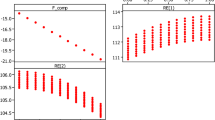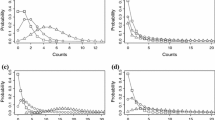Abstract
Taking clue from pioneer work of Chen and Singh (J Mod Appl Stat Methods 11:105–122, 2012), we have suggested a generalized RR procedure, for estimating the multinomial proportions of potentially sensitive attributes in survey sampling, using higher order moments of scrambling variables at the estimation stage to produce unbiased estimators. The RR procedure due to Chen and Singh (J Mod Appl Stat Methods 11:105–122, 2012) is viewed as member of the proposed RR procedure. Expressions for variance and covariance of the suggested generalized estimator with its development are derived. It is found that the developed estimator is more efficient than Warner’s (J Am Stat Assoc 60:63–69, 1965) RRT. A numerical illustration is also given in support of the present study.
Similar content being viewed by others
References
Abernathy JR, Greenberg BG, Horvitz DG (1970) Estimates of induced abortion in urban North Carolina. Demography 7:19–29
Abul-Ela ALA, Greenberg BG, Horvitz DG (1967) A multi-proportions randomized response model. J Am Stat Assoc 62:990–1008
Antonak RF, Livneh H (1995) Direct and indirect methods to measure attitudes toward persons with disabilities, with an exegesis of the error-choice test method. Rehabil Psychol 40(1):3–24
Bourke PD (1981) On the analysis of some multivariate randomized response design of categorical data. J Stat Plan Inference 5:165–170
Bourke PD (1982) RR multivariate designs for categorical data. Commun Stat Theory Methods 11:2889–2901
Bourke PD, Dalenius T (1976) Some new ideas in the realm of randomized inquiries. Int Stat Rev 44:219–221
Bradburn N, Sudman S (1979) Improving interview method and questionnaire design. Jossey-Bass, San-Francisco, pp 1–13
Chaudhuri A, Mukerjee R (1988) Randomized response: theory and techniques. Marcel-Dekker, New York
Chen CC, Singh S (2012) Estimation of multinomial proportions using higher order moments of scrambling variables in randomized response sampling. J Mod Appl Stat Methods 11(1):105–122
Denmark B, Swensson B (1987) Measuring drug use among Swedish adolescents. J Off Stat 3:439–448
Duffy JC, Waterton JJ (1984) Randomized response models for estimating the distribution function of a quantitative character. Int Stat Rev 52:165–172
Eichhorn BH, Hayre LS (1983) Scrambled randomized response methods for obtaining sensitive quantitative data. J Stat Plan Inference 7:307–316
Eriksson SA (1973) A new model for randomized response. Int Stat Rev 41:101–113
Fox JA, Tracy PE (1986) Randomized response: a method of sensitive surveys. SEGE Publications, Newbury Park
Himmelfarb S, Edgell SE (1980) Additive constants model: a randomized response technique for eliminating evasiveness to quantitative response questions. Physiol Bull 87:525–530
Kerkvliet J (1994) Cheating by economics students: a comparison of survey results. J Econ Educ 25:121–133
Kim JJ, Flueck JA (1978) An additive randomized response model. In: Proceedings of the survey research methods section. American Statistical association, pp 351–355
Kim JM, Warde DW (2005) A mixed randomized response model. J Stat Plan Inference 133(1):211–221
Liu PT, Chow LP (1976) A new discrete quantitative randomized response model. J Am Stat Assoc 71:72–73
Pollock KH, Bek Y (1976) A comparison of three randomized response models for quantitative data. J Am Stat Assoc 71:884–886
Scheers NJ (1992) A review of randomized response technique. Meas Eval Couns Dev 25:27–41
Tracy PE, Fox JA (1981) The validity of randomized response for sensitive measurement. Am Sociol Rev 46:187–200
Umesh UA, Peterson RA (1991) A critical evolution of randomized response method. Sociol Method Res 20(1):104–138
Warner SL (1965) Randomized response: a survey technique for eliminating evasive answer bias. J Am Stat Assoc 60:63–69
Acknowledgement
Authors are thankful to the Editor and the learned referee for the kind perusal of the paper and the suggestions given regarding improvement of the paper.
Author information
Authors and Affiliations
Corresponding author
Additional information
Communicated by Haruhiko Ogasawara.
About this article
Cite this article
Singh, H.P., Gorey, S.M. A generalized procedure for estimating the multinomial proportions in randomized response sampling using scrambling variables. Behaviormetrika 46, 5–22 (2019). https://doi.org/10.1007/s41237-018-0054-z
Received:
Accepted:
Published:
Issue Date:
DOI: https://doi.org/10.1007/s41237-018-0054-z
Keywords
- Multinomial proportions
- Unbiased estimators
- Randomized response sampling
- Scrambling variables
- Efficiency




